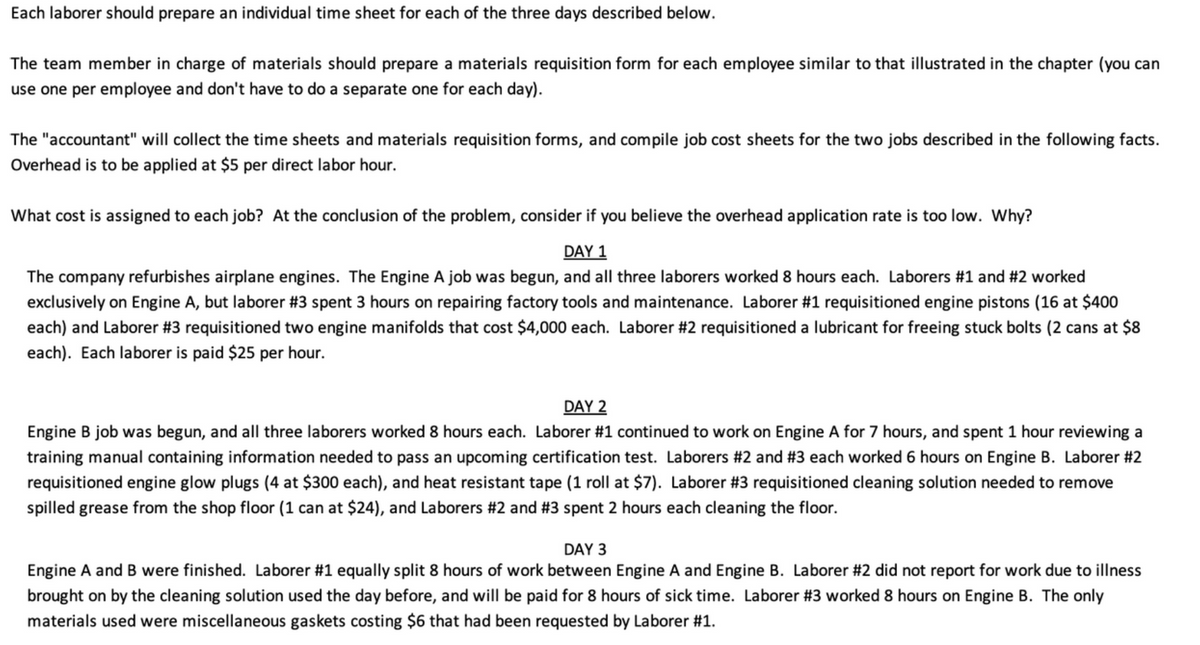ition forms, and
Principles of Cost Accounting
17th Edition
ISBN:9781305087408
Author:Edward J. Vanderbeck, Maria R. Mitchell
Publisher:Edward J. Vanderbeck, Maria R. Mitchell
Chapter9: Cost Accounting For Service Businesses, The Balanced Scorecard, And Quality Costs
Section: Chapter Questions
Problem 8P
Related questions
Question
Prepare time sheets, material requisition forms, and a cost sheet

Transcribed Image Text:Each laborer should prepare an individual time sheet for each of the three days described below.
The team member in charge of materials should prepare a materials requisition form for each employee similar to that illustrated in the chapter (you can
use one per employee and don't have to do a separate one for each day).
The "accountant" will collect the time sheets and materials requisition forms, and compile job cost sheets for the two jobs described in the following facts.
Overhead is to be applied at $5 per direct labor hour.
What cost is assigned to each job? At the conclusion of the problem, consider if you believe the overhead application rate is too low. Why?
DAY 1
The company refurbishes airplane engines. The Engine A job was begun, and all three laborers worked 8 hours each. Laborers #1 and #2 worked
exclusively on Engine A, but laborer #3 spent 3 hours on repairing factory tools and maintenance. Laborer #1 requisitioned engine pistons (16 at $400
each) and Laborer #3 requisitioned two engine manifolds that cost $4,000 each. Laborer #2 requisitioned a lubricant for freeing stuck bolts (2 cans at $8
each). Each laborer is paid $25 per hour.
DAY 2
Engine B job was begun, and all three laborers worked 8 hours each. Laborer #1 continued to work on Engine A for 7 hours, and spent 1 hour reviewing a
training manual containing information needed to pass an upcoming certification test. Laborers #2 and #3 each worked 6 hours on Engine B. Laborer #2
requisitioned engine glow plugs (4 at $300 each), and heat resistant tape (1 roll at $7). Laborer #3 requisitioned cleaning solution needed to remove
spilled grease from the shop floor (1 can at $24), and Laborers #2 and #3 spent 2 hours each cleaning the floor.
DAY 3
Engine A and B were finished. Laborer #1 equally split 8 hours of work between Engine A and Engine B. Laborer #2 did not report for work due to illness
brought on by the cleaning solution used the day before, and will be paid for 8 hours of sick time. Laborer #3 worked 8 hours on Engine B. The only
materials used were miscellaneous gaskets costing $6 that had been requested by Laborer #1.
Expert Solution
This question has been solved!
Explore an expertly crafted, step-by-step solution for a thorough understanding of key concepts.
Step by step
Solved in 3 steps with 5 images

Knowledge Booster
Learn more about
Need a deep-dive on the concept behind this application? Look no further. Learn more about this topic, accounting and related others by exploring similar questions and additional content below.Recommended textbooks for you

Principles of Cost Accounting
Accounting
ISBN:
9781305087408
Author:
Edward J. Vanderbeck, Maria R. Mitchell
Publisher:
Cengage Learning

Cornerstones of Cost Management (Cornerstones Ser…
Accounting
ISBN:
9781305970663
Author:
Don R. Hansen, Maryanne M. Mowen
Publisher:
Cengage Learning

Excel Applications for Accounting Principles
Accounting
ISBN:
9781111581565
Author:
Gaylord N. Smith
Publisher:
Cengage Learning

Principles of Cost Accounting
Accounting
ISBN:
9781305087408
Author:
Edward J. Vanderbeck, Maria R. Mitchell
Publisher:
Cengage Learning

Cornerstones of Cost Management (Cornerstones Ser…
Accounting
ISBN:
9781305970663
Author:
Don R. Hansen, Maryanne M. Mowen
Publisher:
Cengage Learning

Excel Applications for Accounting Principles
Accounting
ISBN:
9781111581565
Author:
Gaylord N. Smith
Publisher:
Cengage Learning

Managerial Accounting
Accounting
ISBN:
9781337912020
Author:
Carl Warren, Ph.d. Cma William B. Tayler
Publisher:
South-Western College Pub

Financial And Managerial Accounting
Accounting
ISBN:
9781337902663
Author:
WARREN, Carl S.
Publisher:
Cengage Learning,

Managerial Accounting: The Cornerstone of Busines…
Accounting
ISBN:
9781337115773
Author:
Maryanne M. Mowen, Don R. Hansen, Dan L. Heitger
Publisher:
Cengage Learning